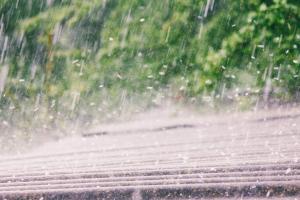
Subtle Signs of Hail Damage Often Overlooked by Property Owners in Wisconsin Rapids
Thad Brown, founder of Dynamic Alliance Roofing LLC in Wisconsin Rapids and a roofing professional with over four decades of experience, explains that hail can leave behind subtle but significant clues that are easy to miss without trained eyes.
“Hail doesn’t always tear through a roof like a wrecking ball,” Brown said. “Sometimes the damage is quiet — bruised shingles, dented vents, or loosened granules. Over time, these weak points can fail, and when they do, it’s often after the storm has long passed.”
Granule Loss
One of the most commonly overlooked signs of hail damage is granule loss. Asphalt shingles are coated in protective granules that shield against UV rays and weather. Hail impact can dislodge these granules, exposing the underlying asphalt. This often appears as dark spots or inconsistent shading across the roof. Left untreated, these areas become vulnerable to premature aging, water penetration, and cracking.
Granules also tend to accumulate in gutters or downspouts after a storm. Heavy deposits should not be ignored, as they are often an early signal that the shingle surface has been compromised.
Soft Spots or Bruising
Another indicator is bruising — areas where hail has impacted the shingle but hasn’t left a visible hole or tear. These spots often feel soft to the touch, like pressing on a bruised piece of fruit. While not visible from the ground, these indentations can weaken the shingle’s integrity and may lead to cracks over time, especially under fluctuating weather conditions.
Professional inspectors often use specialized tools to detect bruising, as the damage tends to remain hidden beneath the shingle surface.
Minor Dents on Metal Components
Hail doesn’t discriminate — flashing, vents, gutters, and metal roof accessories are also targets. Small dents in these components might seem cosmetic at first glance, but they can create weak points for moisture to collect or openings for water intrusion if seams or joints are impacted.
Exhaust caps, ridge vents, and chimney covers are particularly vulnerable. Even shallow dents can lead to gaps in the sealant or structural fatigue that goes unnoticed until moisture finds a way in.
Cracked or Split Shingles
Hail can also cause fine cracks or splits in the fiberglass mat of asphalt shingles. These aren’t always immediately visible, especially on darker roofing materials. Over time, these cracks can expand under heat, freeze-thaw cycles, or heavy rain, eventually resulting in active leaks.
Cracks often appear in a circular or crescent pattern, corresponding to the angle of hail impact. If left unchecked, they may spread like a windshield fracture — quietly growing until failure occurs.
Blistering Confused with Hail Damage
Sometimes, property owners or even inexperienced inspectors mistake manufacturing defects like blistering for hail damage, or vice versa. Blisters appear as raised areas on the shingle surface and are caused by trapped moisture during production. However, hail damage typically shows displaced granules and impact points with directional patterns.
Distinguishing between the two is critical for accurate insurance claims and repair decisions. Brown notes that experienced roofing professionals are trained to identify these differences and document them appropriately.
Ceiling Spots or Attic Dampness Weeks After the Storm
Another sign frequently overlooked is the delayed appearance of moisture inside the home. Water intrusion from minor hail damage may not become visible until the next significant rain. Homeowners might notice ceiling spots, damp insulation, or musty smells in the attic days or weeks after the hailstorm has passed.
This kind of slow-developing damage highlights the need for early inspection — even when exterior damage seems minimal.
Weakened Seal Strips and Lifted Shingles
Hail can disturb the adhesive strip underneath shingles, weakening the bond that keeps them sealed against wind and rain. These shingles may not blow off immediately, but they are now vulnerable to lifting during the next storm event.
Shingles that appear slightly lifted, uneven, or flapping in the wind after hail should be examined for compromised seals, as they are now a point of entry for moisture and debris.
Importance of Timely and Detailed Inspection
Brown emphasizes the need for comprehensive inspections following any significant hail event, even if no major damage is visible from ground level. Roofing systems are complex structures, and minor issues often hide in plain sight.
“Missing a dent or a soft spot today can turn into a costly repair six months from now,” Brown said. “Hail rarely hits in a perfect pattern. One side of a roof might be fine, while another section is riddled with issues. The damage is often directional and uneven.”
Property owners in Wisconsin Rapids are encouraged to have their roofing systems assessed by licensed, local professionals familiar with regional weather patterns and building codes. Timely documentation and professional evaluations can also assist in insurance claims and long-term maintenance planning.
Morgan Thomas
Rhino Digital, LLC
+1 504-875-5036
email us here
Visit us on social media:
Facebook
Distribution channels: Building & Construction Industry, Culture, Society & Lifestyle, Environment, Natural Disasters, Real Estate & Property Management
Legal Disclaimer:
EIN Presswire provides this news content "as is" without warranty of any kind. We do not accept any responsibility or liability for the accuracy, content, images, videos, licenses, completeness, legality, or reliability of the information contained in this article. If you have any complaints or copyright issues related to this article, kindly contact the author above.
Submit your press release

